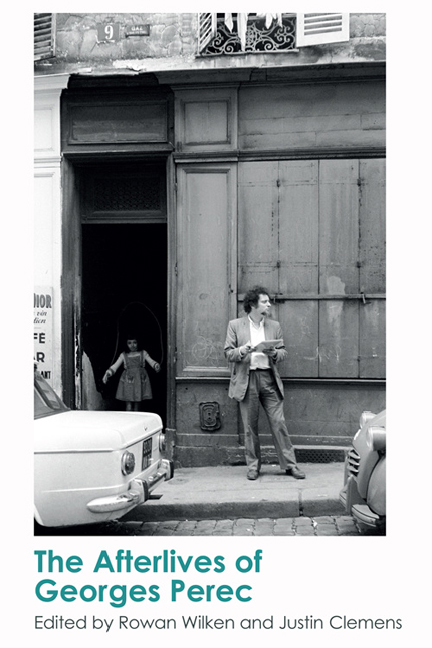Book contents
- Frontmatter
- Contents
- List of Figures
- Acknowledgements
- Notes on Contributors
- 1 Posthumous News: The Afterlives of Georges Perec
- PART I Art of the (Un)realisable
- 2 Georges Perec's Enduring Presence in the Visual Arts
- 3 Apoetic Life: Perec, Poetry, Pneumatology
- 4 UnSearching for Rue Simon-Crubellier: Perec Out-of-Sync
- 5 Invoking the Oracle: Perec, Algorithms and Conceptual Writing
- PART II The Poetics of the Quotidian and Urban Space
- PART III Ludic Intensities and Creative Constraints
- PART IV Productive Problems of Description and Transcription
- Afterword
- Index
2 - Georges Perec's Enduring Presence in the Visual Arts
from PART I - Art of the (Un)realisable
Published online by Cambridge University Press: 07 December 2017
- Frontmatter
- Contents
- List of Figures
- Acknowledgements
- Notes on Contributors
- 1 Posthumous News: The Afterlives of Georges Perec
- PART I Art of the (Un)realisable
- 2 Georges Perec's Enduring Presence in the Visual Arts
- 3 Apoetic Life: Perec, Poetry, Pneumatology
- 4 UnSearching for Rue Simon-Crubellier: Perec Out-of-Sync
- 5 Invoking the Oracle: Perec, Algorithms and Conceptual Writing
- PART II The Poetics of the Quotidian and Urban Space
- PART III Ludic Intensities and Creative Constraints
- PART IV Productive Problems of Description and Transcription
- Afterword
- Index
Summary
Despite his use of diverse techniques, Picasso's work is always the same, like a variation on a single painting. Conversely, each painting by Klee is the solution to a different problem. I am [more] like Klee.
Far from waning, Georges Perec's reputation worldwide is still gathering momentum more than three decades after his untimely death. While his work is often cited as inspirational by established writers, his legacy in the field of literature – with a few exceptions – seldom goes beyond allusions or derivative writing. In the visual arts, however, the resonance of his work appears to be more profound and wide-ranging. Christelle Reggiani suggests that this may be due to the fact that Perec does not have a distinctive discursive style that readily lends itself to literary appropriation or emulation, and that his multi-faceted contribution to literature is based on formal inventiveness rather than idiosyncratic discursive practices centred on the sentence. Furthermore, it is as if he has exhausted the possibilities inherent in each of the various and varied work-specific writing strategies he adopted, leaving his potential followers limited creative options. While Reggiani's analysis goes some way to explain why few writers have been able to simultaneously espouse Perec's aesthetic principles and emulate his practice, it does not altogether account for the strong convergence between his creative concerns and those of visual artists.
Although Perec's early ambition was to become a painter and he did make a number of gouache abstract paintings in the late 1960s, he was only moderately interested in the visual arts, with the exception of cinema. Nevertheless, art played an important role as subject matter and fictional generator in his work – more often than not, as a metaphor for writing– and he collaborated with a number of painters and photographers on catalogues and artists’ books. While there is inevitably some correlation between these aspects of his work and his current status on the art scene, it would be an oversimplification to simply posit a causal relationship between them. It would seem, rather, that the issues tackled by Perec are closely related to those raised in other art forms in the 1960s and 1970s, and the creative strategies he developed in answer to those questions have become increasingly relevant to successive generations of visual artists.
- Type
- Chapter
- Information
- The Afterlives of Georges Perec , pp. 23 - 44Publisher: Edinburgh University PressPrint publication year: 2017



